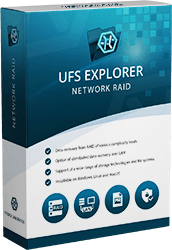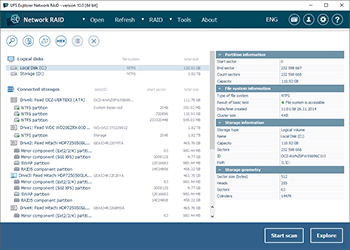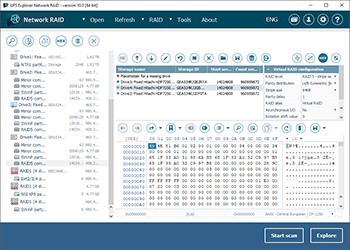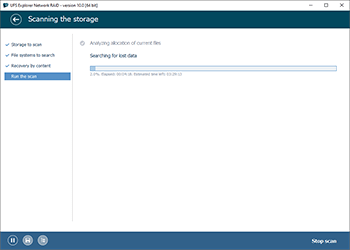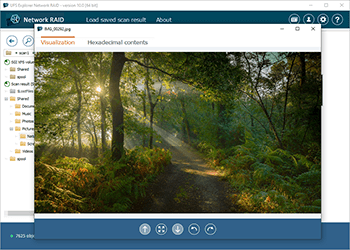UFS Explorer Network RAID

UFS Explorer Network RAID is a universal software application specialized in data recovery from simple digital media and complex RAID sets. Enhanced with LAN-based capabilities, the software allows operating storage devices connected to other remote computers as if they were directly attached to the local machine.
An advantageous solution for various data recovery tasks

deletion

corruption

formatting

crashes

attacks

defects
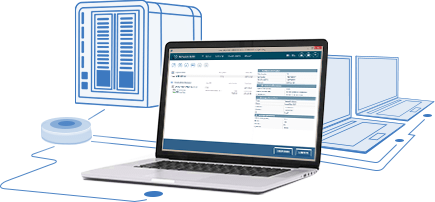
- PCs/laptops
- Hard disk drives
- External USB disks
- USB flash drives
- Memory cards
- Music players
- Digital cameras
- RAID sets
- NAS devices
- SAN systems
- Servers
- Other storage devices
 Documents
Documents Images
Images
 Audio files
Audio files Videos
Videos
 E-mails
E-mails Any other file format
Any other file format
Key features
UFS Explorer Network RAID makes it possible to perform data recovery via LAN when storage devices involved in the procedure are connected to another PC or even several machines powered by different operating systems. Launched concurrently on the host and remote computers, the software provides access to their disks and allows processing them all like locally attached storage media. A RAID set can also be assembled from components distributed between different machines.
UFS Explorer Network RAID supports disk arrays of various configurations: standard RAID patterns (RAID 0, RAID 1, RAID 1E, RAID 3, RAID 5, RAID 6, etc.), nested levels (RAID 10, RAID 50, RAID 60, RAID 50E, etc.) and custom RAID arrangements via RDL or Runtime VIM. The program works with specific RAID layouts as well, which comprise Drobo BeyondRAID, Synology Hybrid RAID and Btrfs-RAID.
UFS Explorer Network RAID allows regaining files lost from NAS devices of popular manufacturers, like Drobo, Buffalo Technology (TeraStation, LinkStation), Synology, QNAP Systems and others. The uility recognizes RAID metadata on NAS drives and employs it to build the array automatically. The storage can also be assembled manually in the virtual mode using an adjustable RAID builder.
The software is apt to perform the adaptive reconstruction of redundant disk arrays (RAID 1, RAID 5, RAID 6, etc.) with the help of bad sector maps created for the RAID elements during their imaging or by recognizing a specified pattern and external ones produced by compatible third-party tools. The application identifies faulty data blocks on disks using their maps and can restore them by means of redundancy (parity information or a copy of data).
Along with RAID, the utility has the ability to process other storage technologies, like Windows Dynamic Disks and Storage Spaces, Apple Software RAID and APFS-based Fusion Drive, Linux mdadm and LVM, virtual disks from common virtual machines, like VMware, Hyper-V, VirtualBox, QEMU and XEN, as well as numerous formats of disk images.
UFS Explorer Network RAID enables the choice of the method for disk access and definition of a timeout for cases when a reading attempt is not successful because of an I/O device error. An integrated disk imager allows customizing the area for imaging and specifying such settings as read timeout, block size, direction, protocol, etc. A range of rules can also be provided for the omission of bad sectors encountered in the process. Such blocks get also indicated in a separate file which can be utilized in other data recovery operations. In addition, the tools like an event log and S.M.A.R.T. monitor considerably help to gain control over the procedure.
The software offers multiple scanning options, among which is a quick scan for chosen file system types, a longer profound search for the missing data by known content with the possibility to apply custom IntelliRAW rules, scanning of the space utilized by the file system or just the “free” areas. The scanning process can be paused and resumed later while its results can be saved to a file for further use.
UFS Explorer Network RAID is supplemented with many functions that serve for the added convenience of users. These include an advanced search function, preview for files of most common formats, like images, PDF documents and text files, sorting files by name, size or date and filtering them by different criteria.
UFS Explorer Network RAID produces maps of defects in the process of disk imaging and supports ones created by certain external solutions. The application can employ such a map for the virtual definition of faulty blocks on the storage or identify damaged sectors dynamically by recognizing a particular content template. The defective regions can also be masked with a given text or hexadecimal pattern.
UFS Explorer Network RAID enables direct access via LAN and data recovery on defective drives connected to a DeepSpar Disk Imager device. The read timeout, block size and other parameters can be defined right in the software, ensuring the maximum safety and efficiency of the procedure.
What's New in Version 10.14
- Intel ISM configurations: fixed issue with detection on image files in some scenarios;
- Microsoft Storage Spaces:
- Added support of SPCACHE storage caching mechanism (used in recent Windows Server versions to speed up 'Parity' volumes);
- Automatic Storage Space assembly procedure is modified to support Transaction log or Cache (if available);
- Automatic procedure now can be configured to not assemble spaces, assemble just a plain volume or assemble with log/cache enabled (default);
- Fixed issue updating configurations with missing drives;
- ReFS file system:
- Fixed issue that caused duplication of files produced by the file system scan in some scenarios;
- Fixed issue with support of reparse points with a shorter metadata chain (ReFS version 3.14);
- Fixed issue displaying of some detected complex volumes (required additional 'refresh' operation);
- Added detection of deleted partitions when disk is initialized with an empty GPT (only 'Reserved' partition is defined);
- ExFAT scan: a couple of fixes for better recovery quality of folder structure.
Frequently asked questions
-
You can download the free Trial version of UFS Explorer Network RAID from this webpage and use it to make sure that the product corresponds to your requirements. The trial software will present all the recovered data and allow copying files with a size of less than 768 KB. Copying bigger files requires activation of the software license.
-
If you are interested in the difference between several UFS Explorer products, please, familiarize yourself with the following comparison table.
-
A license should be selected in accordance with the intended use of the software. The Personal License can be used by a single individual only for personal or educational purposes on home PCs or one computer at work. The Corporate License can be used on up to ten computers owned by a legal entity, company or organization for corporate non-profit or educational purposes. The Commercial License can be used on one computer owned by a legal entity, company or organization for commercial purposes and providing services. For more detailed information please refer to the software licensing page.
-
The license for the software will be provided after a one-time payment of the corresponding license fee. To place an order use the "Buy License" button on this webpage or the "Order license" button from the "Software Activation and License" dialog in the software interface. Choose the needed license type and the operating system you are going to use for the installation of the software. Please note that a single license is applicable for a specific version of the product for one operating system (e.g. Windows OS, both 32-bit and 64-bit) and running the software in other environments requires activating different software licenses. Press "To Checkout" and fill out the billing form. The information needed for the purchase includes first name, last name, address, city, country and email address. All the data and the transaction will be securely processed by our sales partner 2Checkout according to the market security standards.
-
Our sales partner 2Checkout provides a variety of payment options, including Visa/MasterCard, PayPal, American Express, Discover, WebMoney, wire transfer, etc. and allows performing the payment in any currency. For more details, please, visit the global payments page on their website.
-
A Registration Code is issued to either the person's (entrepreneur’s) name or company's name once the payment is processed and is delivered to the email address specified in the order. The delivery is electronic and usually takes about 15-45 minutes.
-
A Registration Code will be sent to the email address specified in your purchase order. To activate the license, download a free Trial version of the software and enter your name with the Registration Code from the email in the "Software Activation and License" dialog.
Other UFS Explorer products
-
NTFS, FAT/FAT32, exFAT, ReFS/ReFS3;
-
Apple HFS+, APFS;
-
XFS, Ext2, Ext3, Ext4, Linux JFS, ReiserFS, UFS/UFS2, big-endian UFS, Btrfs;
-
simple and stripe ZFS volumes.
-
NTFS:
full support: data access, search for lost partitions, RAID recovery, recovery of deleted files, recovery after formatting and file system damage. -
FAT/FAT32/exFAT:
full support: data access, search for lost partitions, recovery of deleted files, recovery after formatting and file system damage. -
ReFS/ReFS3:
full support: data access, search for lost partitions, RAID recovery, recovery of deleted files, recovery after formatting and file system damage. -
XFS:
full support: data access, search for lost partitions, RAID recovery, recovery of deleted files, recovery after formatting and file system damage; support of NAS devices and custom servers. -
Apple HFS+:
full support: data access, search for lost partitions, RAID recovery, recovery of deleted files, recovery after file system damage. -
APFS:
full support: data access, search for lost partitions, RAID recovery, recovery of deleted files, recovery after file system damage. -
Linux JFS:
full support: data access, search for lost partitions, RAID recovery, deleted files recovery, recovery after format and file system damage. -
Ext2-Ext4:
full support: data access, search for lost partitions, RAID recovery, recovery of deleted files, recovery after file system damage; support of NAS devices and custom servers. -
ReiserFS:
full support: data access, search for lost partitions, RAID recovery, recovery of deleted files, recovery after formatting and file system damage. -
Btrfs:
full support: data access, search for lost partitions, RAID recovery, deleted files recovery, recovery after format and file system damage. -
UFS/UFS2:
data access, search for lost partitions, RAID recovery for both little-endian and big-endian variations; recovery after file system damage; very limited recovery of deleted files. -
ZFS:
data access, search for lost partitions, data recovery from simple and stripe volumes, deleted files recovery.
-
Composite volumes: mdadm, LVM, LDM, Apple Software RAID, Intel Matrix;
-
Most standard RAID patterns: RAID 0, RAID 1E, RAID 3, RAID 4, RAID 5, RAID 6, etc.;
-
Nested (Hybrid) RAID levels: RAID 10, RAID 50, RAID 60, RAID 50E, etc.;
-
Non-standard RAID: Drobo BeyondRAID, Synology Hybrid RAID, Btrfs-RAID;
-
Custom RAID patterns: via RAID Definition Language or Runtime VIM;
-
Adaptive RAID reconstruction: RAID 5, RAID 6, RAID 5E, RAID 1, RAID 10, RAID 0+1 and nested RAID (levels 50, 51, 60, 61, etc.) using maps of bad sectors.
-
Virtual disks and disk images: VMware (VMDK), Hyper-V (VHD/VHDX), QEMU/XEN (QCOW/QCOW2), VirtualBox (VDI), EnCase (E01 and Ex01 non-encrypted), Apple Disk Images (DMG), disk images of DeepSpar DDI, R-Studio image files (RDR), simple disk images;
-
Other storage technologies: Microsoft Storage Spaces, Fusion Drive (based on APFS).
-
Network capabilities: Drive sharing over LAN, connecting to a shared storage, direct network access and processing of disks connected via DeepSpar Disk Imager;
-
Tools for low-level data analysis: hexadecimal viewer (for storages, partitions and files);
-
Features for work with damaged disks: configurable drive reading procedure, advanced embedded disk imager, defining damaged regions using bad sector maps (created by UFS Explorer or compatible third-party tools – ACE PC-3000, DeepSpar DDI, etc.), S.M.A.R.T. monitor for drives, event log;
-
Auxiliary options: files preview, search, sorting, filtering and others.
-
The software will copy files the size of which doesn’t exceed 768 KB.
-
Microsoft Windows ®: starting from Windows® XP with Service Pack 3 and later;
-
macOS: all versions starting from 11;
-
Linux: Debian Linux 6.0 (or compatible) and above.
-
Intel Architecture, 32-bit (IA-32, x86);
-
AMD64 (x86-64);
-
Apple Silicon (arm64).
-
Any of the supported host operating systems;
-
at least 20 MB of free space on the disk for the executable files of the software;
-
at least 1 GB of RAM;
-
the Linux software version can run from most modern Linux Live CDs.
-
A 64-bit edition of any of the supported host operating systems;
-
over 1 GB of free space on the disk for the program and temporary files;
-
at least 2 GB of RAM and 4 logical cores CPU;
-
any web browser.
